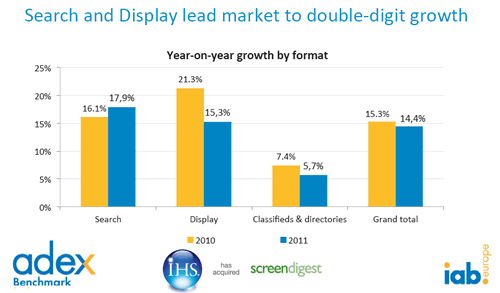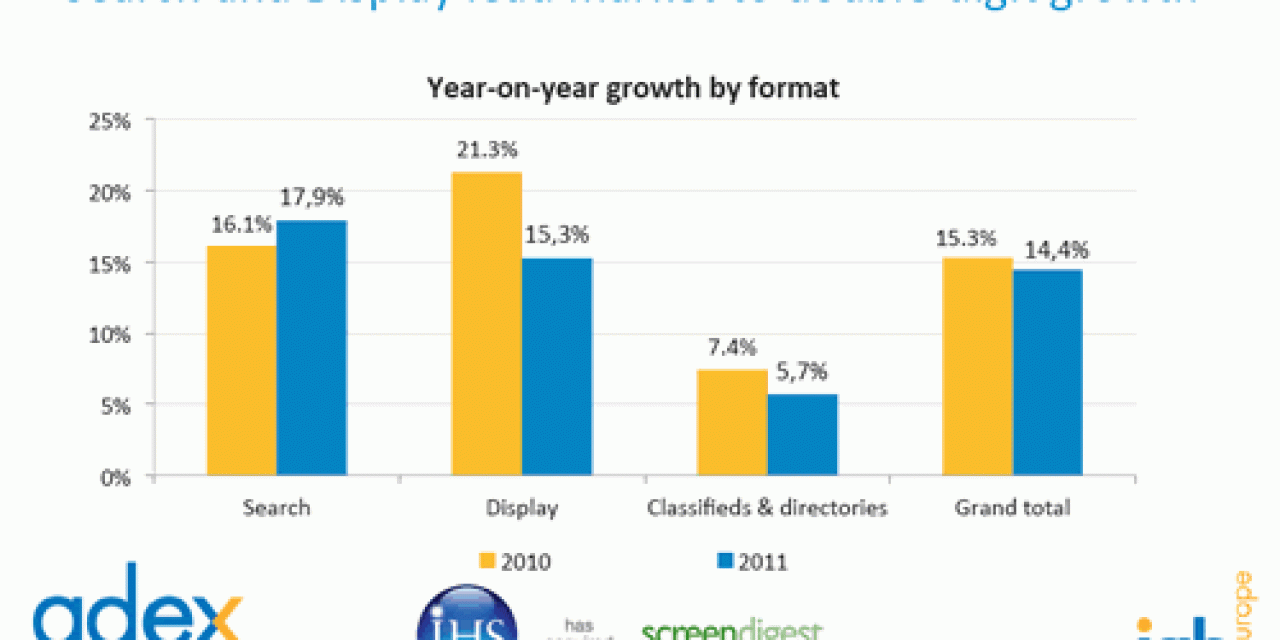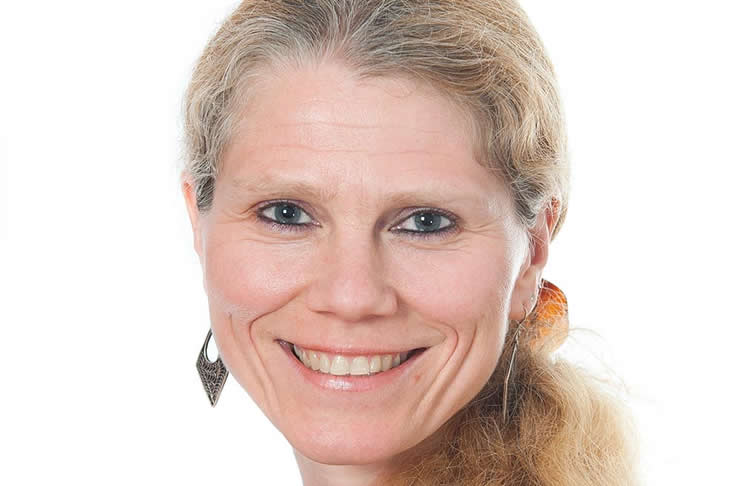According to the IAB Europe AdEx Benchmark Europe 2012, the online advertising market in Europe rose to a total market value of €20.9bn in 2011, a year-over-year growth by 14.5%.
This means that 1 in 5 advertising Euros in Europe is now spent online. IAB Europe emphasizes this growth is realized despite difficult economic circumstances.
It should not come as a surprise that the investments in online advertising keep growing. The same goes for investments in other digital channels and tactics.
There are two important factors to take into account:
- The consumer is increasingly online and using multiple channels so it’s pretty obvious advertisers try to be where the consumers are. Nevertheless, the disconnect between the digital consumer, and the advertiser remains high. The connected consumer leads the dance, where many advertisers simply – and often in vain – try to catch up.
- In times of stagnation and even recession, direct response tactics grow and above-the-line advertising suffers. Since beginning of this year, many brands have postponed or even canceled more integrated campaigns and chosen direct response methods or sales promotions. Ask any serious agency.
In an explanation of the research results, Daniel Knapp, Head of Advertising Research at IHS Screen Digest and author of the research, identified some reasons for the 2011 results. Where it could be expected that in the current macroeconomic environment, the online ad spend would suffer, the opposite seems true. Knapp: “However, online enjoys a number of unique attributes that have protected it from this effect.”

A few of the online advertising evolutions, according to Knapp:
- Advertisers increasingly recognizing online as a branding medium.
- The growth of video, ‘big’ data and enhanced targeting capabilities.
- The sound and measurable results of search.
- Advertisers shifting ad budgets from mature to emerging markets (mainly CEE), where broadband infrastructure is ‘adding to the attractiveness of those markets.’
What about the long term?
The survey results can be seen from various angles, depending on your viewpoint. Where IAB, as an association that wants to defend the online ad industry, obviously presents the results as very rosy, the underlying realities can show an entirely different picture.
Make no mistake: advertisers don’t invest more in digital for the sake of it. They do so mainly because they know the consumer is online, and many are focusing on the short term. In that regard, remember how much marketers spend on getting traffic and how little they spend on optimization and providing better customer experiences online.
While targeting and direct response (e.g. traffic building in an effort to fill the pipe) lead the pack, most businesses fail at optimization and actually doing something with the traffic they generate. Furthermore, recent reports show how, across the globe, marketers fail at having a single customer view or providing consistent cross-channel and multi-channel experiences.
It’s true that better targeting possibilities give the online advertising industry a new impulse. But there are many caveats. Changing legislation and the arrival of new technologies and even browsers that by default might come with ‘do not track’ turned on are just a few challenges. Moreover, targeting technologies still have a long way to go, certainly since there seldom is a truly customer-centric and integrated approach. But most of all, having better targeting possibilities does not equal better targeting.
Finally, the rise of digital advertising as such should not be the goal. The rise of overall efficiency should be. We do live in an integrated world and advertising, regardless of formats or technologies, is not enough. Brands should focus more on living up to their promises instead of making promises. And that’s exactly where many fail.
Where is the innovation?
Some of the results of the IAB Europe AdEx Benchmark Europe 2012 illustrate some of these points:
- The “ROI-centric” (I would say, “direct response driven”) search format grew fastest in 2011, with a growth rate of 17.9%. Indeed, paid search, focused on results and hardly capable of providing value to the consumer. Search now accounts for 46.5% of total online advertising, IAB says. That’s almost half.
- Video and mobile helped lift the value of display ad spend. Or, in other words: video (now representing 8.2% of online display) and mobile advertising (small but growing fast) add fuel to the display ad spend.
In a recent report, Google (that obviously wants to promote online ads) revealed that mobile ad impressions on its networks increased 250% over Q3 and Q4 in 2011. However, other reports show mobile users are not always very happy – to put it mildly – with mobile ads. There is also the question of efficiency and the formats. An Adotas report (PDF opens), for instance, found that 76 percent of calls from mobile display ads are accidental.
Google also found (PDF opens) that the medium rectangle (300×250), leaderboard (728×90) and skyscraper (160×600) constitute 80% of impressions and the traditional 468×60 banner ads are basically dead. The company emphasizes “the opportunity of having richer and more engaging ads….”
Online advertising is changing and, obviously, will not go away anytime soon. However, it’s important to look at things in perspective. Alain Heureux, President and CEO of IAB Europe, concludes that “innovation and diversity have driven the outstanding growth of the European online advertising sector, which now accounts for over 20% of total advertising spend.” Allow me to question that.
Innovation is a dangerous word. It is one thing to use more digital channels but another one to be innovative and relevant for – prospective – customers, across all touchpoints. Furthermore, where is the innovation when it boils down to smart and cross-channel campaigns or an optimized mix? Where’s the innovation regarding making what we do more relevant? How well do we listen to consumers? There is not much innovation in any of these areas. It can also be questioned how innovative the growth of search, for instance, is. Isn’t the real reason of it’s growing share the focus on immediate, quick wins? And what about targeting? Some technologies might be better for advertisers but do we use them to make life of the consumer better?
Finally, note that growth is highest in the CEE countries, with growth rates of 55% in Russia, making Russia the sixth biggest market. The top five markets (UK, Germany, France, Italy, Netherlands) account for almost 67.9% of the total online advertising market. That’s less than in 2010, when they accounted for 69.2%. The chart below leaves no room for interpretation.
Repeat after me: it’s not about the channels
All in all, it’s a very mixed image and, knowing that 2012 so far has been disastrous for many European countries (certainly in the EU region) from an economic viewpoint, maybe it’s best to think more about how we can improve customer experiences in a cross-channel way, how we can optimize what we do and how we can be more valuable to – prospective – customers in general. It’s better to be ‘outstanding’ in that regard than in being ‘outstanding’ in the growth of digital advertising budgets, to paraphrase Heureux.
We should focus more on what we do with people once they ‘find’ us or become customers and what we do after that, across all touchpoints. Let’s be outstanding – or even remarkable – in that regard.
The gap between online advertising spend and optimization budgets is outrageous and businesses that want to make the difference, both in the short and long run, can better focus on the overall experience. We can only hope that associations, such as IAB, don’t just look at the online ad spend market and the interests of the industry but also advocate ‘good and customer-centric’ marketing overall.
It’s not a good time to be proud about 2011. It’s a good time to work hard and improve what we do in 2012 and beyond. And it’s never a good time to be proud of increasing investments in any channel if it doesn’t add value to the lives of today’s consumer. Of course, in the coming days, the media will mostly write that in Europe, advertisers spend more online than before. That’s not a virtue. What matters is whether these budgets are spent wisely or not. And, ultimately, the consumer will decide. Benchmarks are useful but we should put everything in the right perspective and, as advertisers or marketers, not be too proud at all. We can hardly catch up with a fast changing consumer reality. Maybe that is – or could be – the only positive way to look at the numbers: we do more on digital. What we do and how relevant we are is an entirely different question.
Again, it’s not about the channels but about the customer and the bottom-line. Say it to yourself every day.
Agree or disagree? Let me know what you think. The results of the report were announced last week, together with the results of the Mediascope Europe 2012 report.
Update 1: as Aurelie Pols of Mind Your Analytics mentioned in a reaction on Twitter, it’s also important to understand that the marginal costs of online ads are decreasing, adding that “the positive figures are just reflecting the conquest of new markets”.
Update 2: note that in the categorie “others” below, advertising in email is included. Email marketing obviously is not. In regard to advertising on social networks (e.g. Facebook ads), I have no idea if this is taken into account but presumably it’s not. If you know, please let me know.






